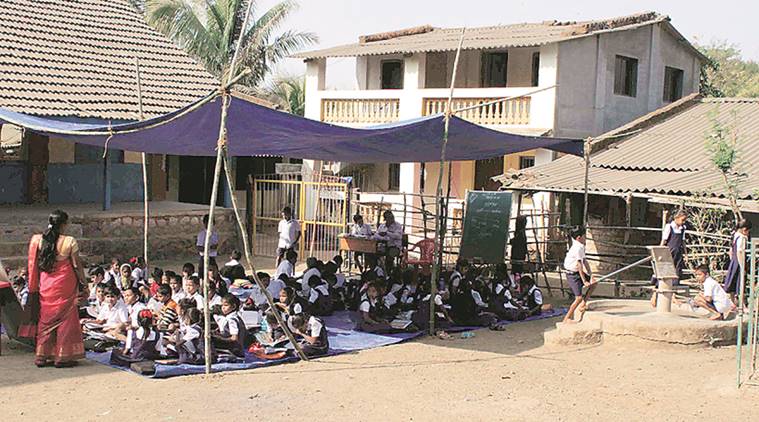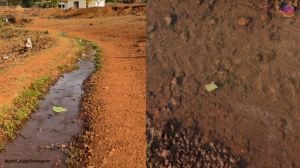- India
- International
Palghar: Villagers settle into routine, fear of earthquake makes way for midnight chatter
Around 10,000 residents of 40 villages, a majority of whom are agricultural labourers and brick kiln workers, are sleeping in the tents, after the frequency of the tremors increased.
 Villagers inside a tent. (Express Photo: Deepak Joshi)
Villagers inside a tent. (Express Photo: Deepak Joshi)
“It is cold, but what if something happens to the children when we are inside the house? I can’t sleep inside thinking the house will collapse on us any moment,” says 62-year-old Sammibai Ghoda.
It is bedtime in Palghar, and Sammibai is sitting under a shelter made of dried fodder and old mats that her 65-year-old husband Ladkya Ghoda has managed to erect outside their home. The couple sleep there with their two grandchildren, aged five and nine, under the starry sky.
The Ghodas, who live in Karanjvira, are one of many families sleeping in the open since seismic tremors became a regular feature in their lives in Dahanu.
Like them, 10,000 residents of 40 villages, a majority of whom are agricultural labourers and brick kiln workers, are sleeping in the open, after the frequency of the tremors increased, in tents erected by them, the district administration and National Disaster Response Force.
Karanjvira, Dhundalwadi and Haladpada are among the 17 villages that have experienced the tremors almost daily since November.

Vasant Kaumb, another Karanjvira resident, has walked with his family of five to a tent he has erected 2 km from his house. “All of us carry torches as a safety precaution against snakes. This is a heavily forested area and snakes and scorpions abound. After a woman was bitten by snake on February 10, we have started bringing sticks with us, to drive them away,” he says, adding, “we walk to the tent after dinner. Sometimes, we set up a bonfire and sit around it, discussing daily issues or politics.”
Some residents have fashioned tents from old sarees and bedsheets, while others have gone a step ahead and got electric connections from nearby houses.
In the tent opposite Kaumb’s, Kakda Bhima has a single bulb connected to his home’s main line. “This is so that the children can finish their school work. We don’t go inside the house after sunset,” says Kakda.
There is a clothesline behind the tent where his family has hung out spare clothes, mostly for his youngest child aged three, who feels cold at night and needs to be layered up.
In Haladpada village, 7 km away, civic officials have set up two tents measuring 50×18 m, just off the Mumbai-Ahmedabad highway. Each tent has five partitions, for individual families. Some families are sharing their “room” with others.
“I usually wait for the sun to set before herding the children to the tent. They were providing food here, but they have stopped now. So, we finish an early dinner and walk here,” says Archana Bond.
Amruta (8) runs around with her friends, just as her mother Anjali scolds her at the camp in Haladpada. “I let the kids run around till 9 pm, so that they tire themselves out and let the elders sleep peacefully,” she says.
With nothing but tarpaulin sheets separating families, all adults are conscious of the need to maintain peace and quiet. As the night progresses, the temperatures drop, forcing the women to wrap themselves in the blankets that have been donated by politicians, who have been visiting since a three-year-old girl died in the area. She ran out of home during one of the many quakes in the last three weeks. “We just sit inside our tents and sleep off,” says Archana.
After more than three months, the villagers have learnt enough about the tremors to have their own categories: if the vessels clatter, serious; if the asbestos sheets on the roof rattle, a warning shout out is sufficient.
The villagers have now fallen into a routine, but they are unsure how long they can keep going. “We spend the daytime in our houses, generally sitting outside. Once the sun sets, we lock our houses and settle in the tents. Food was being provided here by the administration, but now we just bring it from our houses. The kids are put to sleep first, and slowly all the adults sleep too,” says Aravind Tumbe (40).
He adds, “Earlier, we had nothing. Slowly, someone donated tarpaulin sheets, then blankets. If it is not enough, we share.” While the tents have no ventilation, there is no provision of toilets, for which the villagers either run to their houses or use open areas nearby.
While in Haladpada, no one sits vigil, in Karanjvira, a couple of men or women have vigil duty every night. Vinnibai Gawali (48) ensures that when she is on night duty, her friends are too. “We sit together near the fences of our house and chatter away into the night. My daughter-in-law sleeps with the children inside the tent. She comes in the middle sometimes to check on me,” she laughs.
In Dhundalwadi, Ullas Satvi, headmaster of Dhundalwadi Ashramshala, says he has been deprived of a good night’s sleep for two months. “I have around 400 residential children, including girls. I had begged the authorities to give us tents in November. When no one paid heed, I invested money and asked help from a Mumbai-based NGO and got a big tent in my compound. The junior kids sleep there,” he says. Of 400 residential students, 342 still remain in the ashramshala.
He adds, “After the 4.1 Richter scale earthquake on February 1, the parents (of the children in the ashramshala) were concerned. I tried to convince them, but one of them said they would rather their child died with them. What can you say then?”
The girls in the ashramshala are still living in their hostel, as there aren’t enough tents. “I am so proud of my girls, they are strong. They told me that they will not panic in case of an emergency and conducted drills on their own to convince me. But I worry,” says Satvi.
According to the Dahanu tehsildar Rahul Sarang, more than 900 tents have been supplied to the villages in and around Dhundalwadi. “We have given bigger tents and small tents for individual families. I don’t have a break-up of each village, but we are working on providing everyone with a shelter,” he says.
Patrolling the area in the middle of night is a team of medics associated with the 108-ambulance. “Whenever there is a big tremor, we wait for phone calls. If none comes, we just patrol the area, checking if anyone needs help in the night,” says ambulance pilot Vasudev Wagh, adding, “we buy the big can of water to drink. If we need to use the washroom, we drive 10 km away to the outpost where we are usually posted. We use the washroom there, take our showers. I pick up a vada pao on my way back and forth, and that’s my food for the past two days,” he recounts. “There are no facilities here, but we are expected to help people in case of an emergency,” he adds.
Dahanu MLA Paskal Dhangare from the BJP says, “I am personally monitoring the situation now. The tremors didn’t begin in November, they have started now and we are working on providing every house with a tent. Work is in progress.”
As soon as dawn breaks, at around 5 am, the families mobilise themselves, most of them carrying the still sleeping children. “It’s a rush to get the children ready and for us to cook tiffin for the children and the men. All of this has to be done at 8 am, and after that once everyone leaves the house, we women sit outside, near our tents,” says Archana.
While the men rush to work, they drop off the kids at the Dhundalwadi zilla parishad shala, where a tent with tarpaulin was raised on Thursday. “The classes for the youngest students are conducted under the tarpaulin, while the older children are still inside the school,” says teacher Manjusha Mandvi.
Apr 26: Latest News
- 01
- 02
- 03
- 04
- 05








































